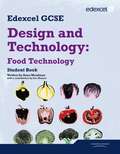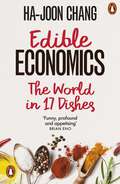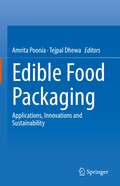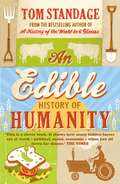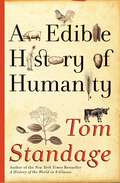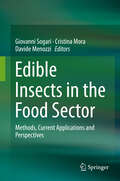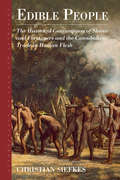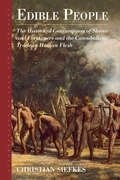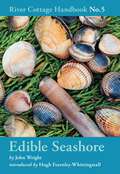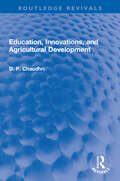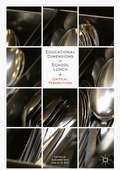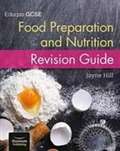- Table View
- List View
Edexcel GCSE: Student Book (PDF)
by Sue Manser Anna WoodmanA controlled assessment chapter provides step-by-step guidance and advice on the controlled assessment criteria. ResultsPlus features combine examiner insight with real exam performance data to illustrate clearly how students can improve their own answers to exam questions. Examzone revision resources for each topic make revision easy. Contents include: Nutrition Primary and secondary foods Preservation and processing Product manufacture Analysing product Creative design and make activities
The Edible Atlas: Around the World in Thirty-Nine Cuisines
by Mina Holland'A delight to read' RACHEL KHOO Shortlisted for the 2015 Fortnum & Mason Food Book Award Winner of UK's Best Culinary Travel Book in the Gourmand World Cookbook Awards 2015 'When we eat, we travel.' So begins The Edible Atlas. Mina Holland takes you on a journey around the globe, demystifying the flavours, ingredients and techniques at the heart of thirty-nine cuisines. What's the origin of kimchi in Korea? Why do we associate Argentina with steak? What's the story behind the curries of India? Weaving anecdotes and history - from the role of a priest in the genesis of camembert to the Mayan origins of the word 'chocolate' - with recipes and tips from food experts such as Yotam Ottlolenghi, Jos� Pizarro and Giorgio Locatelli, The Edible Atlas is an irresistible tour of the cuisines of the world for food lovers and armchair travellers alike.
The Edible City: A Year of Wild Food
by John Rensten"The foodie book of the year" The Spectator''An inspiring book for city dwellers who pine for the bounty of a countryside hedgerow' Sunday Times'The forager's magic trick; To conjure a meal out of seemingly nothing and ensure you never look the same way at a neglected green space again' Daily Telegraph'I love the idea that I could pick up dinner from a local park rather than from a shop on the way home. A book about urban forging could so easily have been worthy, but it's an entertaining read with recipes: get ready for nettle tempura...' Delicious magazine'A man after my own heart.' Mark Hix'That is the final act of the forager's magic trick. To conjure a meal out of seemingly nothing, and ensure you never look the same way at a neglected green space again' The TelegraphOnce you start foraging, you'll never look at the city around you in the same way again.As we walk through the city with our headphones in or our eyes glued to screens, it's easy to forget that we are surrounded by wonderful things to eat. Our parks, pathways, gardens and wild spaces are crammed full of delicious, nutrient-rich plants; all we need to know is how to find them. From dandelions to winter cress, wild garlic to chickweed and ground ivy to water mint, this book takes us through a year of delicious, foraged food. Each entry is illustrated in colour to help you identify the plant and followed by a recipe using these remarkable ingredients. In The Edible City, urban forager John Rensten gives us the tools to identify, source and cook delicious food from the year-long bounty around us, whether that's nettle and three-cornered leek gnocchi, winter purslane pesto, or stinging nettle tempura.This account of a year of urban foraging is perfect for any nature lover or home cook looking for exciting new ingredients to experiment with.
Edible DIY: Simple, Giftable Recipes to Savor and Share
by Lucy BakerEdible DIY may not be the first book for crafty cooks and burgeoning urban homesteaders, but it is the easiest. Based on the popular Serious Eats column by the same name, Edible DIY includes 75 recipes divided into five chapters: Crunchy, Boozy, Sweet, Spicy, and Jars. With plenty of packaging tips throughout, Edible DIY is the perfect solution for making inexpensive edible gifts in your own kitchen with everything from Chocolate-Peppermint Marshmallows and Coconut Granola to Homemade Sriracha and Espresso Barbeque Sauce. Illustrated with inspirational full-color photography throughout.
Edible Economics: A Hungry Economist Explains the World
by Ha-Joon ChangRADIO 4 BOOK OF THE WEEK Economic thinking - about globalisation, climate change, immigration, austerity, automation and much more - in its most digestible formFor decades, a single free market philosophy has dominated global economics. But this is bland and unhealthy - like British food in the 1980s, when bestselling author and economist Ha-Joon Chang first arrived in the UK from South Korea. Just as eating a wide range of cuisines contributes to a more interesting and balanced diet, so too is it essential we listen to a variety of economic perspectives.In Edible Economics, Chang makes challenging economic ideas more palatable by plating them alongside stories about food from around the world. He uses histories behind familiar food items - where they come from, how they are cooked and consumed, what they mean to different cultures - to explore economic theory. For Chang, chocolate is a life-long addiction, but more exciting are the insights it offers into post-industrial knowledge economies; and while okra makes Southern gumbo heart-meltingly smooth, it also speaks of capitalism's entangled relationship with freedom and unfreedom. Explaining everything from the hidden cost of care work to the misleading language of the free market as he cooks dishes like anchovy and egg toast, Gambas al Ajillo and Korean dotori mook, Ha-Joon Chang serves up an easy-to-digest feast of bold ideas.Myth-busting, witty and thought-provoking, Edible Economics shows that getting to grips with the economy is like learning a recipe: if we understand it, we can change it - and, with it, the world.
The Edible Flower: A Modern Guide to Growing, Cooking and Eating Edible Flowers
by Erin Bunting Jo FacerOn a seven-acre small holding in rural Northern Ireland, organic gardener Jo Facer and head chef Erin Bunting run fork-to-fork supper club, organic small-holding and fledgling cooking and growing school, The Edible Flower. In their first cookbook, learn to grow and cook edible flowers with Jo and Erin's delicious recipes inspired by the seasonal produce they grow in their kitchen garden and the wild food they forage from their local shores and hedgerows. Feast, celebrate and bring people together with over 50 recipes for small plates, mains, desserts, baking, snacks and drinks, at once fresh and flavourful and absolutely stunning to serve. Recipes include: Ribboned Courgette & Avocado Salad with Poppy Seeds & Calendula, Pot Marigold Soda Bread,Lilac Panna Cotta with Strawberries,Rice with Lemon Verbena, Cardamom & Edible Flower Petals,Marigold Petal Pasta,Courgette Flower Tacos,Carnation and Blackberry Cooler,Slow Roast Lamb with Lavender, Lemon & Apricots, Blackberry & Sweet Geranium Tart,Vietnamese Summer Rolls with Violas,Aubergine Katsu Curry with Pickled Magnoliaand many more ...
Edible Food Packaging: Applications, Innovations and Sustainability
by Amrita Poonia Tejpal DhewaThis book discusses the various aspects of sustainable packaging edibles in food industry. It is divided into five main parts. The first section of the book addresses details of edible films, various sources, origin, scope and functions. Second section covers different sustainable alternatives such as seed gums, fruits and vegetable peels, sea weeds, fruits wastes, dairy by products & anti-oxidant edible packaging. This book also discusses about methods of improvements of mechanical properties of packaging edibles & their food applications, testing methods, innovations, limitations, challenges and nano edibles. It provides insights about the large quantity of wastes and by-products generated by food processing industries. Disposal of these wastes is a big problem due to their high biochemical oxygen demand (BOD) & chemical oxygen demand (COD) which causes severe problem of pollution to the environment. These wastes contain large amounts of proteins, carbohydrates, lipids, minerals, various bioactive compounds and have eco-friendly packaging potential. The book emphasizes on the fact that recycling these wastes as packaging edibles are sustainable and economical. As a world foreseeing food technology revolution, this book explores the unique topics in food packaging which possesses mammoth commercial applications and environmental potential. Due to its immense scope, this book is highly useful for researchers, food scientists, students and food packaging industry experts.
Edible Fungi of Britain and Northern Europe: How to Identify, Collect and Prepare (WILDGuides #119)
by Jens H. PetersenA richly illustrated guide to edible mushrooms by one of Europe’s leading fungi expertsIn this beautifully illustrated introductory guide, Jens Petersen shows how to successfully identify and forage for edible mushrooms, and then how to prepare them for the table to ensure a delicious culinary experience, even if you're a first-time forager.Accessible and user-friendly, the book opens with a substantial introduction to fungi—what to look for, where to find them and how to collect and cook them. Other topics include edible and poisonous fungi, conserving mushrooms and other uses of fungi. The book then covers the most common major groups, including morels, wood cauliflower, polypores, boletes, tooth fungi, chanterelles, horn of plenty, brittlegills, milkcaps, agarics, puffballs and jelly fungi. For many of these groups, notable subkinds are given their own treatment. With practice, the book will enable you to identify mushrooms such as yellow chanterelles, blueing boletes with orange tube mouths, green brittlegills and milkcaps with orange milk.Featuring more than 400 stunning colour photographs and more than forty black-and-white illustrations, this book will enhance the experience of every mushroom forager and wild-table chef.
An Edible History of Humanity
by Tom StandageThroughout history, food has done more than simply provide sustenance. It has acted as a tool of social transformation, political organization, geopolitical competition, industrial development, military conflict and economic expansion. In An Edible History of Humanity Tom Standage serves up a hugely satisfying account of ways in which food has, indirectly, helped to shape and transform societies around the world. It is a dazzling account of gastronomic revolutions from pre-history to the present.
An Edible History of Humanity
by Tom StandageThe bestselling author of A History of the World in 6 Glasses charts an enlightening history of humanity through the foods we eat.Throughout history, food has done more than simply provide sustenance. It has acted as a tool of social transformation, political organization, geopolitical competition, industrial development, military conflict and economic expansion. An Edible History of Humanity is an account of how food has helped to shape and transform societies around the world, from the emergence of farming in China by 7,500 BCE to today's use of sugar cane and corn to make ethanol. Food has been a kind of technology, a tool that has changed the course of human progress. It helped to found, structure, and connect together civilizations worldwide, and to build empires and bring about a surge in economic development through industrialization. Food has been employed as a military and ideological weapon. And today, in the culmination of a process that has been going on for thousands of years, the foods we choose in the supermarket connect us to global debates about trade, development and the adoption of new technologies. Drawing from many fields including genetics, archaeology, anthropology, ethno-botany and economics, the story of these food-driven transformations is a fully satisfying account of the whole of human history.
Edible Insects in the Food Sector: Methods, Current Applications and Perspectives
by Giovanni Sogari Cristina Mora Davide MenozziThis book explores one of the most discussed and investigated novel foods in recent years: edible insects. The increasing demand for alternative protein sources worldwide had led the Food and Agriculture Organization of the United Nations (FAO) to promote the potential of using insects both for feed and food, establishing a program called “Edible Insects.” Although several social, environmental, and nutritional benefits of the use of insects in the human diet have been identified, the majority of the population in Western countries rejects the idea of adopting insects as food, predominantly for cultural reasons. Nevertheless, international interest in promoting the consumption of insects has grown significantly, mainly in North America and Europe. This trend is mostly due to increasing attention and involvement from the scientific network and the food and feed industries, as well as governments and their constituents. The book explores the current state of entomophagy and identifies knowledge gaps to inform primary research institutions, students, members of the private sector, and policymakers to better plan, develop, and implement future research studies on edible insects as a sustainable source of food. The case studies and issues presented in this book cover highly up-to-date topics such as aspects of safety and allergies for human consumption, final meat quality of animals fed with insects, the legislative framework for the commercialization of this novel food, and other relevant issues.
Edible Memory: The Lure of Heirloom Tomatoes and Other Forgotten Foods
by Jennifer A. JordanEach week during the growing season, farmers’ markets offer up such delicious treasures as brandywine tomatoes, cosmic purple carrots, pink pearl apples, and chioggia beets—varieties of fruits and vegetables that are prized by home chefs and carefully stewarded by farmers from year to year. These are the heirlooms and the antiques of the food world, endowed with their own rich histories. While cooking techniques and flavor fads have changed from generation to generation, a Ribston Pippin apple today can taste just as flavorful as it did in the eighteenth century. But how does an apple become an antique and a tomato an heirloom? In Edible Memory, Jennifer A. Jordan examines the ways that people around the world have sought to identify and preserve old-fashioned varieties of produce. In doing so, Jordan shows that these fruits and vegetables offer a powerful emotional and physical connection to a shared genetic, cultural, and culinary past. Jordan begins with the heirloom tomato, inquiring into its botanical origins in South America and its culinary beginnings in Aztec cooking to show how the homely and homegrown tomato has since grown to be an object of wealth and taste, as well as a popular symbol of the farm-to-table and heritage foods movements. She shows how a shift in the 1940s away from open pollination resulted in a narrow range of hybrid tomato crops. But memory and the pursuit of flavor led to intense seed-saving efforts increasing in the 1970s, as local produce and seeds began to be recognized as living windows to the past. In the chapters that follow, Jordan combines lush description and thorough research as she investigates the long history of antique apples; changing tastes in turnips and related foods like kale and parsnips; the movement of vegetables and fruits around the globe in the wake of Columbus; and the poignant, perishable world of stone fruits and tropical fruit, in order to reveal the connections—the edible memories—these heirlooms offer for farmers, gardeners, chefs, diners, and home cooks. This deep culinary connection to the past influences not only the foods we grow and consume, but the ways we shape and imagine our farms, gardens, and local landscapes. From the farmers’ market to the seed bank to the neighborhood bistro, these foods offer essential keys not only to our past but also to the future of agriculture, the environment, and taste. By cultivating these edible memories, Jordan reveals, we can stay connected to a delicious heritage of historic flavors, and to the pleasures and possibilities for generations of feasts to come.
Edible Memory: The Lure of Heirloom Tomatoes and Other Forgotten Foods
by Jennifer A. JordanEach week during the growing season, farmers’ markets offer up such delicious treasures as brandywine tomatoes, cosmic purple carrots, pink pearl apples, and chioggia beets—varieties of fruits and vegetables that are prized by home chefs and carefully stewarded by farmers from year to year. These are the heirlooms and the antiques of the food world, endowed with their own rich histories. While cooking techniques and flavor fads have changed from generation to generation, a Ribston Pippin apple today can taste just as flavorful as it did in the eighteenth century. But how does an apple become an antique and a tomato an heirloom? In Edible Memory, Jennifer A. Jordan examines the ways that people around the world have sought to identify and preserve old-fashioned varieties of produce. In doing so, Jordan shows that these fruits and vegetables offer a powerful emotional and physical connection to a shared genetic, cultural, and culinary past. Jordan begins with the heirloom tomato, inquiring into its botanical origins in South America and its culinary beginnings in Aztec cooking to show how the homely and homegrown tomato has since grown to be an object of wealth and taste, as well as a popular symbol of the farm-to-table and heritage foods movements. She shows how a shift in the 1940s away from open pollination resulted in a narrow range of hybrid tomato crops. But memory and the pursuit of flavor led to intense seed-saving efforts increasing in the 1970s, as local produce and seeds began to be recognized as living windows to the past. In the chapters that follow, Jordan combines lush description and thorough research as she investigates the long history of antique apples; changing tastes in turnips and related foods like kale and parsnips; the movement of vegetables and fruits around the globe in the wake of Columbus; and the poignant, perishable world of stone fruits and tropical fruit, in order to reveal the connections—the edible memories—these heirlooms offer for farmers, gardeners, chefs, diners, and home cooks. This deep culinary connection to the past influences not only the foods we grow and consume, but the ways we shape and imagine our farms, gardens, and local landscapes. From the farmers’ market to the seed bank to the neighborhood bistro, these foods offer essential keys not only to our past but also to the future of agriculture, the environment, and taste. By cultivating these edible memories, Jordan reveals, we can stay connected to a delicious heritage of historic flavors, and to the pleasures and possibilities for generations of feasts to come.
Edible Memory: The Lure of Heirloom Tomatoes and Other Forgotten Foods
by Jennifer A. JordanEach week during the growing season, farmers’ markets offer up such delicious treasures as brandywine tomatoes, cosmic purple carrots, pink pearl apples, and chioggia beets—varieties of fruits and vegetables that are prized by home chefs and carefully stewarded by farmers from year to year. These are the heirlooms and the antiques of the food world, endowed with their own rich histories. While cooking techniques and flavor fads have changed from generation to generation, a Ribston Pippin apple today can taste just as flavorful as it did in the eighteenth century. But how does an apple become an antique and a tomato an heirloom? In Edible Memory, Jennifer A. Jordan examines the ways that people around the world have sought to identify and preserve old-fashioned varieties of produce. In doing so, Jordan shows that these fruits and vegetables offer a powerful emotional and physical connection to a shared genetic, cultural, and culinary past. Jordan begins with the heirloom tomato, inquiring into its botanical origins in South America and its culinary beginnings in Aztec cooking to show how the homely and homegrown tomato has since grown to be an object of wealth and taste, as well as a popular symbol of the farm-to-table and heritage foods movements. She shows how a shift in the 1940s away from open pollination resulted in a narrow range of hybrid tomato crops. But memory and the pursuit of flavor led to intense seed-saving efforts increasing in the 1970s, as local produce and seeds began to be recognized as living windows to the past. In the chapters that follow, Jordan combines lush description and thorough research as she investigates the long history of antique apples; changing tastes in turnips and related foods like kale and parsnips; the movement of vegetables and fruits around the globe in the wake of Columbus; and the poignant, perishable world of stone fruits and tropical fruit, in order to reveal the connections—the edible memories—these heirlooms offer for farmers, gardeners, chefs, diners, and home cooks. This deep culinary connection to the past influences not only the foods we grow and consume, but the ways we shape and imagine our farms, gardens, and local landscapes. From the farmers’ market to the seed bank to the neighborhood bistro, these foods offer essential keys not only to our past but also to the future of agriculture, the environment, and taste. By cultivating these edible memories, Jordan reveals, we can stay connected to a delicious heritage of historic flavors, and to the pleasures and possibilities for generations of feasts to come.
Edible Memory: The Lure of Heirloom Tomatoes and Other Forgotten Foods
by Jennifer A. JordanEach week during the growing season, farmers’ markets offer up such delicious treasures as brandywine tomatoes, cosmic purple carrots, pink pearl apples, and chioggia beets—varieties of fruits and vegetables that are prized by home chefs and carefully stewarded by farmers from year to year. These are the heirlooms and the antiques of the food world, endowed with their own rich histories. While cooking techniques and flavor fads have changed from generation to generation, a Ribston Pippin apple today can taste just as flavorful as it did in the eighteenth century. But how does an apple become an antique and a tomato an heirloom? In Edible Memory, Jennifer A. Jordan examines the ways that people around the world have sought to identify and preserve old-fashioned varieties of produce. In doing so, Jordan shows that these fruits and vegetables offer a powerful emotional and physical connection to a shared genetic, cultural, and culinary past. Jordan begins with the heirloom tomato, inquiring into its botanical origins in South America and its culinary beginnings in Aztec cooking to show how the homely and homegrown tomato has since grown to be an object of wealth and taste, as well as a popular symbol of the farm-to-table and heritage foods movements. She shows how a shift in the 1940s away from open pollination resulted in a narrow range of hybrid tomato crops. But memory and the pursuit of flavor led to intense seed-saving efforts increasing in the 1970s, as local produce and seeds began to be recognized as living windows to the past. In the chapters that follow, Jordan combines lush description and thorough research as she investigates the long history of antique apples; changing tastes in turnips and related foods like kale and parsnips; the movement of vegetables and fruits around the globe in the wake of Columbus; and the poignant, perishable world of stone fruits and tropical fruit, in order to reveal the connections—the edible memories—these heirlooms offer for farmers, gardeners, chefs, diners, and home cooks. This deep culinary connection to the past influences not only the foods we grow and consume, but the ways we shape and imagine our farms, gardens, and local landscapes. From the farmers’ market to the seed bank to the neighborhood bistro, these foods offer essential keys not only to our past but also to the future of agriculture, the environment, and taste. By cultivating these edible memories, Jordan reveals, we can stay connected to a delicious heritage of historic flavors, and to the pleasures and possibilities for generations of feasts to come.
Edible People: The Historical Consumption of Slaves and Foreigners and the Cannibalistic Trade in Human Flesh (Anthropology of Food & Nutrition #11)
by Christian SiefkesWhile human cannibalism has attracted considerable notice and controversy, certain aspects of the practice have received scant attention. These include the connection between cannibalism and xenophobia: the capture and consumption of unwanted strangers. Likewise ignored is the connection to slavery: the fact that in some societies slaves and persons captured in slave raids could be, and were, killed and eaten. This book explores these largely forgotten practices and ignored connections while making explicit the links between cannibal acts, imperialist influences and the role of capitalist trading practices. These are highly important for the history of the slave trade and for understanding the colonialist history of Africa.
Edible People: The Historical Consumption of Slaves and Foreigners and the Cannibalistic Trade in Human Flesh (Anthropology of Food & Nutrition #11)
by Christian SiefkesWhile human cannibalism has attracted considerable notice and controversy, certain aspects of the practice have received scant attention. These include the connection between cannibalism and xenophobia: the capture and consumption of unwanted strangers. Likewise ignored is the connection to slavery: the fact that in some societies slaves and persons captured in slave raids could be, and were, killed and eaten. This book explores these largely forgotten practices and ignored connections while making explicit the links between cannibal acts, imperialist influences and the role of capitalist trading practices. These are highly important for the history of the slave trade and for understanding the colonialist history of Africa.
Edible Seashore: River Cottage Handbook No.5 (River Cottage Handbook)
by John WrightIn the fifth of the River Cottage Handbook series, John Wright reveals the rich pickings to be had on the seashore - and the team at River Cottage explain how to cook them to perfection.For the forager, the seashore holds surprising culinary potential. In this authoritative, witty book John Wright takes us on a trip to the seaside. But before introducing us to the various species to be harvested, he touches on such practicalities as conservation and the ethics of foraging; safety from tides, rocks and food poisoning; the law and access to the shore, our right to fish, landing sizes and seasons; and equipment such as nets, pots and hooks. Next comes the nitty-gritty: all the main British seashore species that one might be tempted to eat. The conservation status, taste and texture, availability, seasonality, habitat, collecting technique and biology of each species is covered; there are also quite a few gratuitous but fascinating diversions. The species covered includecrustacea (brown shrimp, common crab, lobster, prawn, shore crab, spider crab, squat lobster, velvet swimming crab); molluscs (clams, cockle, dog whelk, limpet, mussel, oyster, razor clam, winkle); mushrooms; plants (alexanders, babbington's orache, fennel, frosted orache, marsh samphire, perennial wall rocket, rock samphire, sea beet, sea buckthorn, sea holly, sea kale, sea purslane, sea rocket, spear-leaved orache, wild cabbage, wild thyme); and seaweed (carragheen, dulse, gut weed, laver, pepper dulse, sea lettuce, sugar kelp, kelp). Finally, there are thirty brilliant recipes. Introduced by Hugh Fearnley-Whittingstall, Edible Seashore is destined to join the other handbooks in the series as an indispensable household reference.
Edible Wild Plants of the Carolinas: A Forager’s Companion (Southern Gateways Guides)
by Lytton John Musselman Peter W. SchafranForaging edible plants was once limited to specialists, survivalists, and herbalists, but it's become increasingly mainstream. Influenced by the popularity of the locavore movement, many restaurants feature foraged plants on their menus, and a wide variety of local foraged plants are sold at farmers markets across the country. With Edible Wild Plants of the Carolinas, Lytton John Musselman and Peter W. Schafran offer a full-color guide for the everyday forager, featuring: - Profiles of more than 100 edible plants, organized broadly by food type, including seeds, fruits, grains, and shoots- Details about taste and texture, harvesting tips, and preparation instructions- Full-color photos that make it easy to identify edible plantsEdible Wild Plants of the Carolinas is designed to help anyone enjoy the many wild plants found in the biodiverse Carolinas.
Edna Lewis: At the Table with an American Original
by Sara B. FranklinEdna Lewis (1916-2006) wrote some of America's most resonant, lyrical, and significant cookbooks, including the now classic The Taste of Country Cooking. Lewis cooked and wrote as a means to explore her memories of childhood on a farm in Freetown, Virginia, a community first founded by black families freed from slavery. With such observations as "we would gather wild honey from the hollow of oak trees to go with the hot biscuits and pick wild strawberries to go with the heavy cream," she commemorated the seasonal richness of southern food. After living many years in New York City, where she became a chef and a political activist, she returned to the South and continued to write. Her reputation as a trailblazer in the revival of regional cooking and as a progenitor of the farm-to-table movement continues to grow. In this first-ever critical appreciation of Lewis's work, food-world stars gather to reveal their own encounters with Edna Lewis. Together they penetrate the mythology around Lewis and illuminate her legacy for a new generation.The essayists are Annemarie Ahearn, Mashama Bailey, Scott Alves Barton, Patricia E. Clark, Nathalie Dupree, John T. Edge, Megan Elias, John T. Hill (who provides iconic photographs of Lewis), Vivian Howard, Lily Kelting, Francis Lam, Jane Lear, Deborah Madison, Kim Severson, Ruth Lewis Smith, Toni Tipton-Martin, Michael W. Twitty, Alice Waters, Kevin West, Susan Rebecca White, Caroline Randall Williams, and Joe Yonan. Editor Sara B. Franklin provides an illuminating introduction to Lewis, and the volume closes graciously with afterwords by Lewis's sister, Ruth Lewis Smith, and niece, Nina Williams-Mbengue.
Education, Innovations, and Agricultural Development: A Study of North India (1961-72) (Routledge Revivals)
by D. P. ChaudhriFirst published in 1979, Education, Innovations, and Agricultural Development investigates the effect of education on agricultural productivity and innovations that took place in the wake of the Green Revolution in North India, using a simultaneous equations model. The Green Revolution of the 1960s, with its twin aims of raising production and improving the quality of input, was expected to induce a majority of farming families to respond to policies and programmes devised for bringing about development in agricultural sectors. Focusing on the wheat-growing areas of Punjab and Haryana, where high yielding varieties of seed have been introduced extensively, it shows that general education up to secondary level has a significant impact on the diffusion of technology and agricultural productivity and that higher production in turn increases the demand for education. This book deserves to be read by all concerned with development in Asian countries; agriculture; developmental economics; and educationists.
Education, Innovations, and Agricultural Development: A Study of North India (1961-72) (Routledge Revivals)
by D. P. ChaudhriFirst published in 1979, Education, Innovations, and Agricultural Development investigates the effect of education on agricultural productivity and innovations that took place in the wake of the Green Revolution in North India, using a simultaneous equations model. The Green Revolution of the 1960s, with its twin aims of raising production and improving the quality of input, was expected to induce a majority of farming families to respond to policies and programmes devised for bringing about development in agricultural sectors. Focusing on the wheat-growing areas of Punjab and Haryana, where high yielding varieties of seed have been introduced extensively, it shows that general education up to secondary level has a significant impact on the diffusion of technology and agricultural productivity and that higher production in turn increases the demand for education. This book deserves to be read by all concerned with development in Asian countries; agriculture; developmental economics; and educationists.
Educational Dimensions of School Lunch: Critical Perspectives
by Suzanne Rice A. G. RudSchool lunch is often regarded as a necessary but inconvenient distraction from the real work of education. Lunch, in this view, is about providing students the nourishment they need in order to attend to academic content and the tests that assess whether content has been learned. In contrast, the central purpose of this collection is to examine school lunch as an educational phenomenon in its own right. Contributing authors—drawing from a variety of disciplinary traditions, including philosophy, sociology, and anthropology—examine school lunch policies and practices, social and cultural aspects of food and eating, and the relation among school food, the environment, and human and non-human animal well-being. The volume also addresses how school lunch might be more widely conceptualized and practiced as an educational undertaking.
Educational Dimensions of School Lunch: Critical Perspectives
by Suzanne Rice A. G. RudSchool lunch is often regarded as a necessary but inconvenient distraction from the real work of education. Lunch, in this view, is about providing students the nourishment they need in order to attend to academic content and the tests that assess whether content has been learned. In contrast, the central purpose of this collection is to examine school lunch as an educational phenomenon in its own right. Contributing authors—drawing from a variety of disciplinary traditions, including philosophy, sociology, and anthropology—examine school lunch policies and practices, social and cultural aspects of food and eating, and the relation among school food, the environment, and human and non-human animal well-being. The volume also addresses how school lunch might be more widely conceptualized and practiced as an educational undertaking.
Eduqas GCSE Food Preparation and Nutrition: Revision Guide (PDF)
by Jayne HillWritten by an experienced Food Preparation and Nutrition examiner and author and endorsed by Eduqas, this comprehensive revision guide has been designed to accompany you through the full GCSE Food Preparation and Nutrition course, and is an ideal preparation for your final exam.
